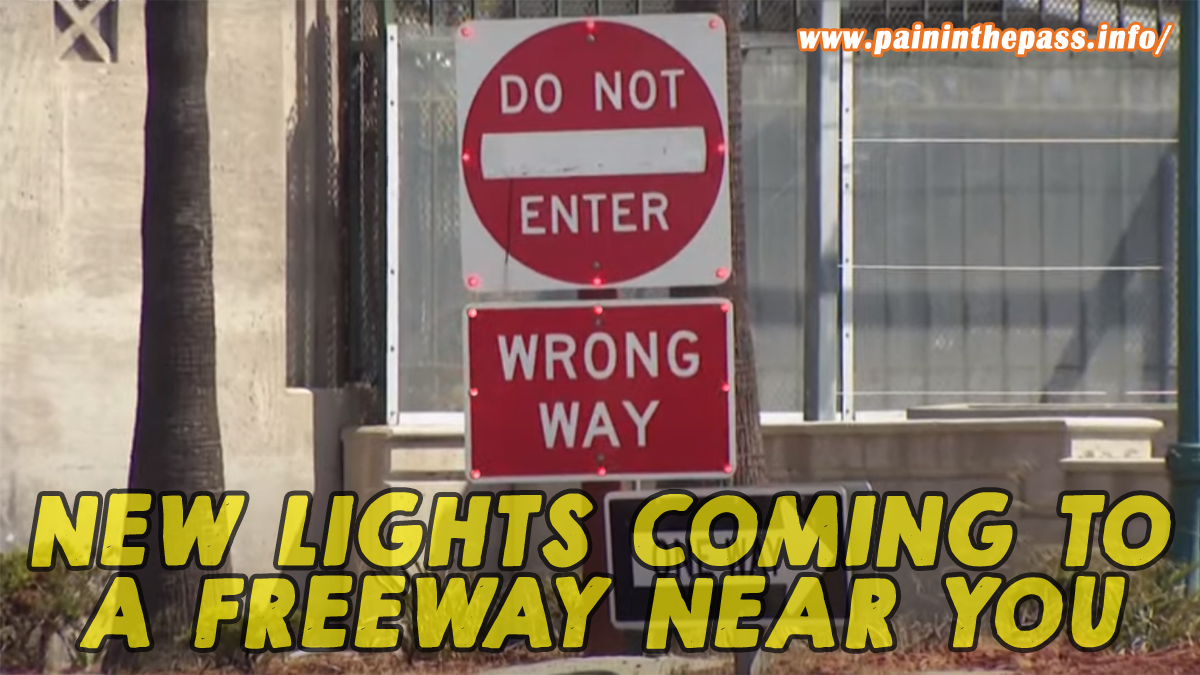SAN BERNARDINO, CA. (Pain In The Pass) >> New wrong-way lights and signs are being installed on various offramps starting this week. You will starting seeing blinking red lights in the near future.
Caltrans and the UC Davis Advanced Highway Maintenance and Construction Technology (AHMCT) Research Center today released two reports highlighting ways to prevent rare but often deadly collisions involving wrong way drivers. One of the prevention measures included in the three-year pilot program—reflectors that alert drivers they are entering the roadway in the wrong direction—was so successful at deterring wrong way drivers that Caltrans has already installed the reflective markers on hundreds of miles of highways.
In San Diego, the number of wrong way drivers decreased by 44% after the reflectors were installed.
“Adding the two-way reflective markers proved to be so effective that Caltrans updated its statewide design standards,” said Caltrans Director Toks Omishakin. “It’s a low-cost measure we can use throughout the state to deter wrong way drivers and potentially save lives on California’s highway system.”
During the pilot program, Caltrans installed and tested different ways to deter wrong way drivers along exit ramps in Sacramento and San Diego, including:
- Two-way reflective pavement markers that show white or yellow to right way drivers, and red to wrong way drivers
- “Wrong Way” signs at the off-ramp
- “Do Not Enter” signs equipped with LED lights flashing 24 hours a day
- Active monitoring systems that use radar to detect wrong way drivers. These systems activate a secondary set of LED signs when a wrong way driver enters the ramp and sends real-time alerts and photos to Caltrans and the California Highway Patrol (CHP).
Caltrans monitored the exit ramps throughout the pilot and learned the two-way reflective pavement markers were an effective measure against wrong way drivers. The department is installing them as it performs maintenance or repaving.
The flashing LED signs showed promise at preventing wrong way collisions and Caltrans will continue to monitor their impact to determine whether to expand use at exit ramps across the state.
The pilot was developed following 10 wrong way driver related collisions on Sacramento and San Diego area freeways in the first six months of 2015. During the three-year pilot program, UC Davis AHMCT researchers partnered with Caltrans to conduct a second study using a Vision-Based Site Monitoring (VBSM) system in Sacramento to better understand the actions that lead to wrong way driving incidents.
“Our hypothesis was that some of the causes of wrong way driving start before a driver enters the ramp,” said researcher and AHMCT co-director Ty Lasky, who helped lead the study. “In order to test this, we wanted to extend our field of view to capture as much of the roadway around the exit ramp as possible.”
The VBSM system consisted of a camera, analytical software, solar panels, and a modem mounted on poles near exit ramps. The system recorded video when the camera detected a wrong way driver, which allowed the team to study a vehicle’s path before, during, and after a wrong way driving incident.
“The video gave us a more comprehensive understanding of driver behavior and factors that contribute to wrong way driving,” said UC Davis Distinguished Professor and AHMCT co-director Bahram Ravani. “This opens the door for further deployment of our system across the state as counties and municipalities try to mitigate wrong way driving.”
Wrong way collisions on divided highways in California are rare—accounting for about 1% of all crashes on the state highway system.
“Wrong way crashes do not happen very often but when they do occur, they are typically head-on crashes, resulting in death or severe injuries,” said CHP Commissioner Warren Stanley. “Information obtained through this pilot program is being used to help prevent these crashes and save lives on California roadways.”
On average, 37 people are killed in wrong way collisions each year on California’s highways. Most wrong way incidents are caused by drivers who are severely impaired and occur in the left-hand lane for vehicles traveling in the correct direction.
“Seeing someone driving the wrong direction is a scary sight and a clear danger to other road users,” said Office of Traffic Safety (OTS) Director Barbara Rooney. “Maintaining safe driving behaviors is critical in preventing crashes that have tragic consequences.”
The Advanced Highway Maintenance and Construction Technology Research Center is part of the UC Davis Department of Mechanical and Aerospace Engineering. The center develops and tests new and advanced technologies to improve the safety, reliability and efficiency of highway maintenance and construction tasks.
They are starting to install the new Wrong Way Prevention Lights and Signs on each offramp in California. Ramp closures this week are on Interstate 215.
Tuesday April 19, 2022 at 9am to 5pm*.
- Northbound I-215 Fifth Street (Route 66) ramp
- Northbound I-215 Palm Ave/Kendall Dr. ramp
- Northbound I-215 Devore Road ramp
- Southbound I-215 Inland Center Drive ramp
- Southbound I-215 Mill Street ramp
- Southbound I-215 Third Street ramp
Wednesday April 20, 2022 at 9am to 5pm*.
- Northbound I-215 Fifth Street (Route 66) ramp
- Northbound I-215 Highland Ave. ramp
- Southbound I-215 Mt. Vernon Ave/27th Street ramp
- Southbound I-215 Baseline Street ramp
- Southbound I-215 Third Street ramp
*Ramps can be closed for 45 minutes at a time during construction hours. Times can subject to change and could go longer. Schedules are subject to change due to inclement weather or construction issues.
There are more ways to follow the Pain In The Pass. Join the Traffic Group on Facebook with over 108,000 members. Join the NEW group on MeWe. Like us on Facebook, Follow us on Twitter and Instagram.

